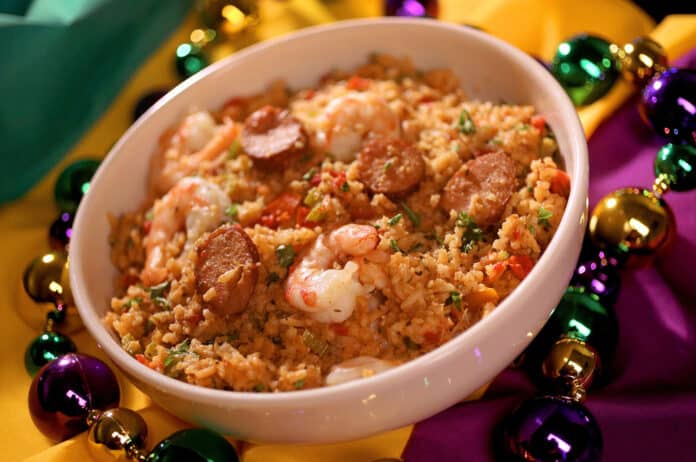By Daniel Neman, St. Louis Post-Dispatch
The woman eyed me not with suspicion but with curiosity, or perhaps amusement.
We were at a grocery store. We were first looking for sausage at the same time, and then we were standing together in front of the shrimp.
“Are we here for the same reason?” she said. “Are you making jambalaya, too?”
Of course I was. It was Carnival. Mardi Gras was fast approaching (it’s Feb. 16).
Carnival, and especially Mardi Gras, are like a last fling, one final chance at debauchery — or at least gluttony and perhaps drunkenness — before the religious austerity and meditation of Lent.
Mardi Gras is celebrated around the world, but in America it is inextricably linked to New Orleans — despite the best efforts of Soulard. Even those of us who are less likely to partake of the general licentiousness look to New Orleans for inspiration in cooking Mardi Gras food.
For my own celebration, I cooked four and a half dishes that represent some of the Big Easy’s best-known foods. The half-dish is just rice, but it is unusually good rice. And you can’t have red beans and rice without rice.
In some respects, red beans and rice is the blood that flows through the veins of New Orleans. Louis Armstrong, perhaps the most New Orleanian of all New Orleanians, used to sign his letters “Red beans and ricely yours.” For that reason alone, I knew I had to make it.
Also, I happen to love red beans and rice.
The secret to making it is time; this is a dish that takes a while to cook. You could speed it up by starting with canned beans instead of dry, but you would miss out on the near-miraculous blending of flavors that comes with a two-hour simmer on the stove.
You don’t even soak the beans first; that would shorten the cooking time.
Like so much New Orleans cooking, Red Beans and Rice begins with what is known as the trinity: onions, celery and green bell pepper. Ham hocks and bay leaves add their contributions, with chopped green onions providing a pungent edge just before serving.
Served on ordinary rice, this dish would be memorable. But I served it on John Besh’s Basic Louisiana White Rice, which is so good you may never want to make plain white rice again.
You begin by sautéing minced onion in butter, chicken fat or olive oil. The dry rice is then cooked in that mixture for a couple of minutes before you add chicken stock, a bay leaf and a pinch of salt.
You know how rice usually has little flavor of its own and acts merely as a pleasant background for other food? Well, this is the opposite of that.
Meanwhile, if you’re going to have big fun on the bayou, you’ll probably want to be doing it with jambalaya. Jambalaya is basically the New Orleans version of paella, the robustly seasoned national dish of Spain: rice simmered with broth, herbs, spices and an assortment of meats and fish.
Jambalaya traditionally has sausage and shrimp in it, as my grocery-store friend knows well, but I like chicken in mine, too. The more the merrier, I say. My version also incorporates the trinity, of course, along with a bay leaf, smoked paprika, celery salt, thyme and Creole seasoning, a blend that you can either buy in the store or easily make yourself.
In New Orleans, they add tomatoes to their jambalaya, which makes it Creole style. In Southwest Louisiana, they make it Cajun style, without tomatoes. I wanted a New Orleans Mardi Gras, so I used tomatoes. I like it spicy, too, so I used tomatoes with green chiles. Son of a gun!
It is a waste of a trip to New Orleans if you don’t have oysters. Lots and lots of oysters. You can get them raw, you can get them grilled and you can get them fried.
I like them fried, but then again I also like them raw and grilled. But for my Mardi Gras feast, I fried them.
There are two secrets to making spectacular fried oysters. The first is soaking the oysters in a flavored buttermilk mixture before frying them. The second is coating them in a combination of flour and cornmeal, which gives them a highly satisfying crunch.
The subtle sweetness of the corn goes particularly well with the briny oysters, too.
The problem with oysters is that they can be hard to find in the middle of the country. I bought mine at Whole Foods, though seafood stores should have them, too.
Dessert was a difficult choice, because New Orleans is famously home to an impressive number of great desserts — beignets, pralines, Bananas Foster, pecan pie and king cake, among others. After relatively little thought, I chose bread pudding. With bourbon cream sauce. And spiced whipped cream. You can see why it did not take much thought to choose it.
This is one of those cases where the whole is better than the sum of its parts, which is astonishing because each part is amazing in its own right.
The bread pudding itself is rich and creamy, with bourbon, brown sugar, cinnamon and vanilla, flavors that elevate any custard. Slightly stale bread is soaked in this cream-and-egg mixture for two full hours before cooking, so when it is baked the cubes of bread form a homogenous, delectable loaf.
The pudding would be exceptional on its own, but then you spoon a sweet cream sauce over it. The sauce is thickened with cornstarch dissolved in bourbon, which is an absolutely brilliant idea by the recipe’s author, Emeril Lagasse, one of New Orleans’ most celebrated chefs.
The bread pudding with the bourbon cream sauce by themselves would have been enough.
But then Lagasse kicks it up another level, so to speak, by topping it with whipped cream spiced with cinnamon and a hint of nutmeg.
If you closed your eyes, you’d swear you’re in New Orleans.
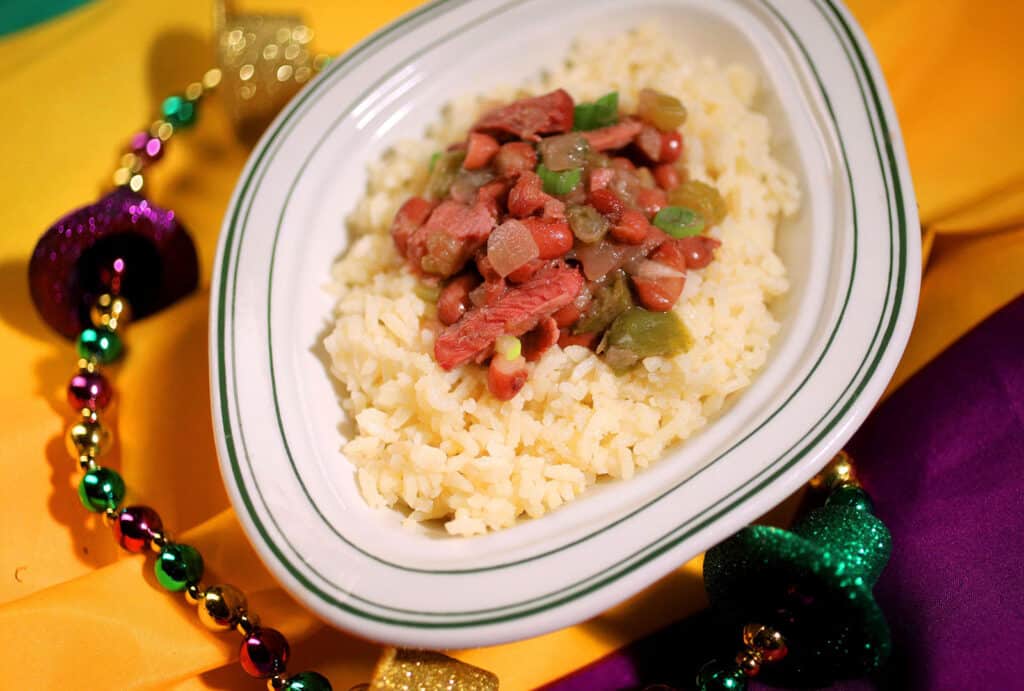
RED BEANS AND RICE
Yield: 8 servings
2 onions, diced
1 green pepper, seeded and diced
1 rib celery, diced
2 tablespoons rendered bacon fat or other flavorful fat such as duck fat or olive oil
1 pound dried red kidney beans
2 smoked ham hocks
3 bay leaves
1/2 teaspoon cayenne pepper
3 green onions, chopped
Salt and pepper
Vinegar-based hot sauce, such as Tabasco or Crystal
4 cups cooked Basic Louisiana White Rice, see recipe
1. Sweat the onions, bell peppers and celery in the rendered bacon fat in a heavy soup pot over medium-high heat.
2. Once the onions become translucent, add the kidney beans, ham hocks, bay leaves and cayenne, then add water to cover by 2 inches.
3. Increase the heat and bring the water to a boil. Cover the pot, reduce the heat to low, and allow the beans to slowly simmer for 2 hours. Periodically stir the beans to make sure they don’t scorch on the bottom of the pot, adding water if necessary, always keeping the beans covered by 1 inch or more of water.
4. Continue cooking the beans until they are creamy and beginning to fall apart when they’re served.
5. Remove the ham hock meat from the bones, roughly chop it and add it back to the pot of beans.
6. Stir in the green onions and season heavily with salt (beans need a lot of salt), black pepper and hot sauce. Serve with white rice.
Per serving: 246 calories; 8 g fat; 2 g saturated fat; 8 mg cholesterol; 8 g protein; 35 g carbohydrate; 2 g sugar; 5 g fiber; 491 mg sodium; 56 mg calcium
Recipe from “My New Orleans: The Cookbook” by John Besh
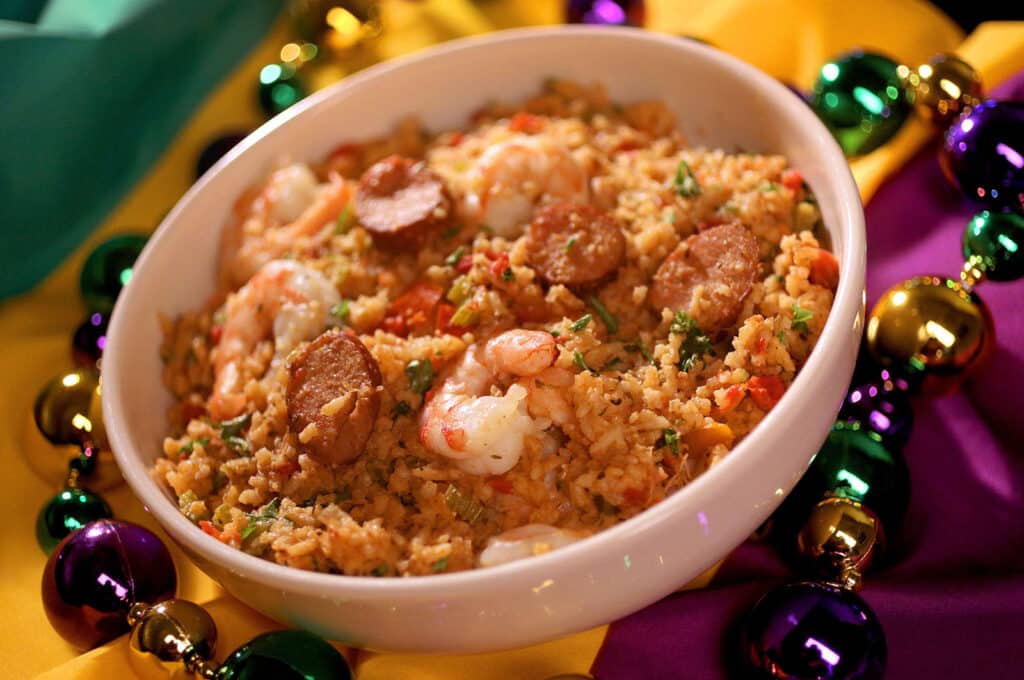
JAMBALAYA
Yield: 8 to 10 servings
2 tablespoons canola oil
1 pound andouille sausage, sliced
Salt and pepper
4 boneless, skinless chicken thighs, cut into 1-inch pieces
2 cups diced onion
1 cup diced celery
1 large red bell pepper, diced
4 garlic cloves, minced
1 bay leaf
2 teaspoons Creole seasoning, see note
1 teaspoon dried thyme
3/4 teaspoon celery salt
1 1/2 teaspoons smoked paprika
2 cups uncooked long-grain rice
2 (10-ounce) cans diced tomatoes and green chiles, such as Rotel
3 cups chicken broth
1 pound peeled raw shrimp, deveined
1/2 cup chopped fresh parsley
4 chopped green onions
Note: Creole seasoning is available in the spice aisle of many grocery stores, or you can make it yourself by combining 1 teaspoon onion powder, 1 teaspoon garlic powder, 1 teaspoon dried oregano, 1 teaspoon dried basil, 1/2 teaspoon dried thyme, 1/2 teaspoon black pepper, 1/2 teaspoon white pepper, 1/2 teaspoon cayenne pepper, 21/2 teaspoons paprika and 1 1/2 teaspoons salt.
1. Heat oil in a large Dutch oven or stock pot until hot; add sausage and cook until browned on both sides, stirring frequently. Season chicken with salt and pepper, add to pot and cook until browned on all sides, stirring frequently. Add onion and cook, stirring occasionally, until brown, about 15 minutes.
2. Add celery, red bell pepper and garlic, and sauté until soft, about 5 minutes. Add bay leaf, 2 teaspoons of Creole seasoning, thyme, celery salt, smoked paprika and rice; cook 2 minutes, stirring. Add tomatoes and broth. Bring to a boil, lower temperature to low, cover and simmer 15 minutes, stirring frequently.
3. Stir in shrimp and parsley. Cook until shrimp are pink and curled, from 2 to 5 minutes depending on their size. Stir in chopped green onions and serve.
Per serving (based on 8): 408 calories; 10 g fat; 2 g saturated fat; 168 mg cholesterol; 32 g protein; 46 g carbohydrate; 5 g sugar; 3 g fiber; 923 mg sodium; 102 mg calcium
Recipe by Daniel Neman (Creole seasoning recipe adapted from allrecipes.com)
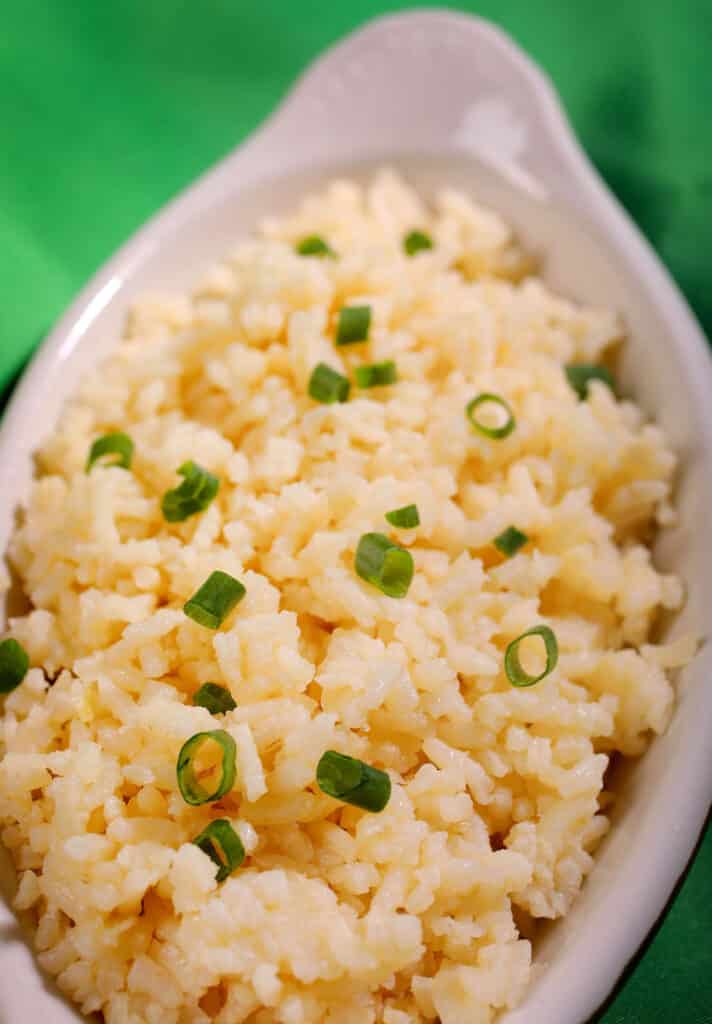
BASIC LOUISIANA WHITE RICE
Yield: 6 servings
1 tablespoon chicken fat, extra-virgin olive oil or butter
1 small onion, minced
1 1/2 cups long-grain white rice
3 cups chicken stock
1 bay leaf
1 to 2 pinches salt
1. Put the fat, oil or butter and the onions into a medium saucepan and sweat the onions over moderate heat until they are translucent, about 5 minutes. Pour the rice into the pan and stir for 2 minutes. Then add the chicken stock and bring to a boil. Add the bay leaf and the salt.
2. Cover the pan with a lid, reduce the heat to low and cook for 18 minutes. Remove the pan from the heat, fluff the rice with a fork, and serve.
Per serving: 252 calories; 4 g fat; 2 g saturated fat; 9 mg cholesterol; 9 g protein; 35 g carbohydrate; 2 g sugar; 5 g fiber; 432 mg sodium; 55 mg calcium
Recipe from “My New Orleans: The Cookbook” by John Besh
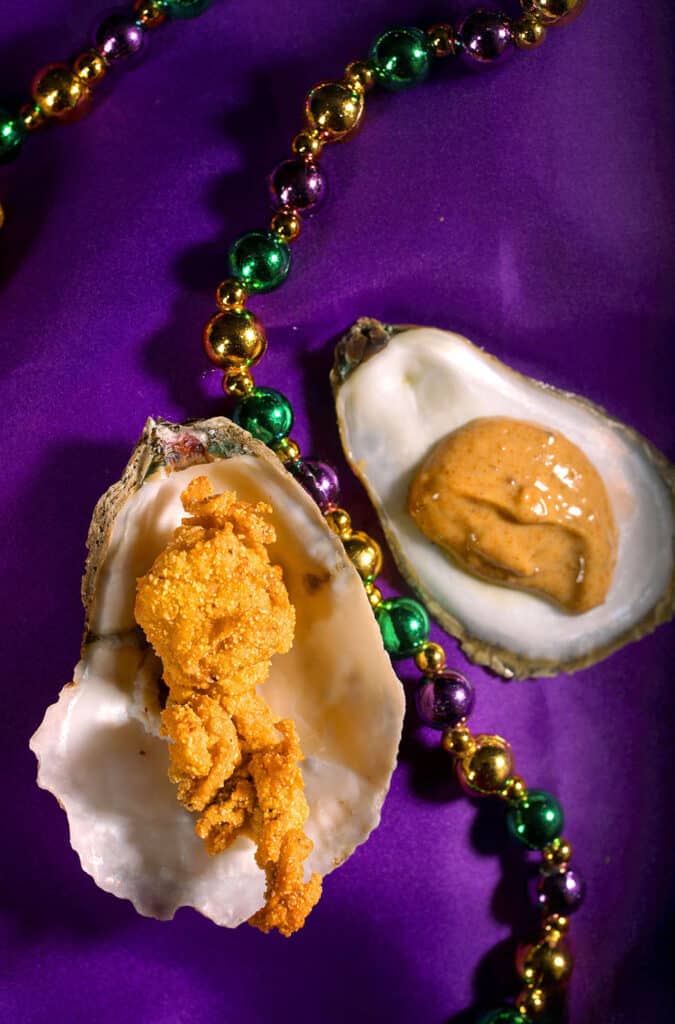
FRIED OYSTERS
Yield: 3 servings
For the remoulade sauce
1/2 cup mayonnaise
1 1/2 teaspoons Creole mustard, see notes
1 1/2 teaspoons paprika
1 1/2 teaspoons white wine vinegar
1 1/2 teaspoons Worcestershire sauce
Dash hot sauce
Salt and pepper
For the oysters
Peanut oil, for frying
3/4 cup buttermilk
1 teaspoon garlic powder
1 teaspoon paprika
Dash hot sauce, such as Tabasco
1/2 cup cornmeal
1/2 cup all-purpose flour
18 shucked oysters, see notes
Notes: Creole mustard is available at most grocery stores, or you can somewhat re-create the flavor by mixing 11/2 teaspoons Dijon mustard with a dash of Worcestershire sauce and a dash of hot sauce.
• Shucked oysters are oysters that have been removed from their shell; this requires a special shucking knife (a sturdy glove helps, too). Shucked oysters can also be purchased in a can; they are fine for frying.
1. To make the remoulade sauce, mix together the mayonnaise, mustard, paprika, vinegar, Worcestershire sauce and hot sauce in a small bowl until well combined. Season with salt and pepper. Serve immediately or cover with plastic wrap and refrigerate until serving.
2. Heat about 3 inches of oil in a pot to 350 degrees.
3. Whisk together the buttermilk, garlic powder, paprika and hot sauce in a bowl. Whisk together the flour, cornmeal, salt and pepper together in a separate bowl.
4. Add the oysters to the buttermilk and let soak. Then remove, letting the excess drip off, and dredge through the cornmeal mixture, tapping off the excess. Fry in the hot oil in batches, until golden and crisp, about 2 minutes. Remove to a paper towel-lined plate and sprinkle with salt and pepper. Serve hot with the remoulade sauce.
Per serving: 515 calories; 27 g fat; 5 g saturated fat; 160 mg cholesterol; 32 g protein; 35 g carbohydrate; 2 g sugar; 2 g fiber; 1,340 mg sodium; 63 mg calcium
Recipe by Patrick and Gena Neely, via Food Network
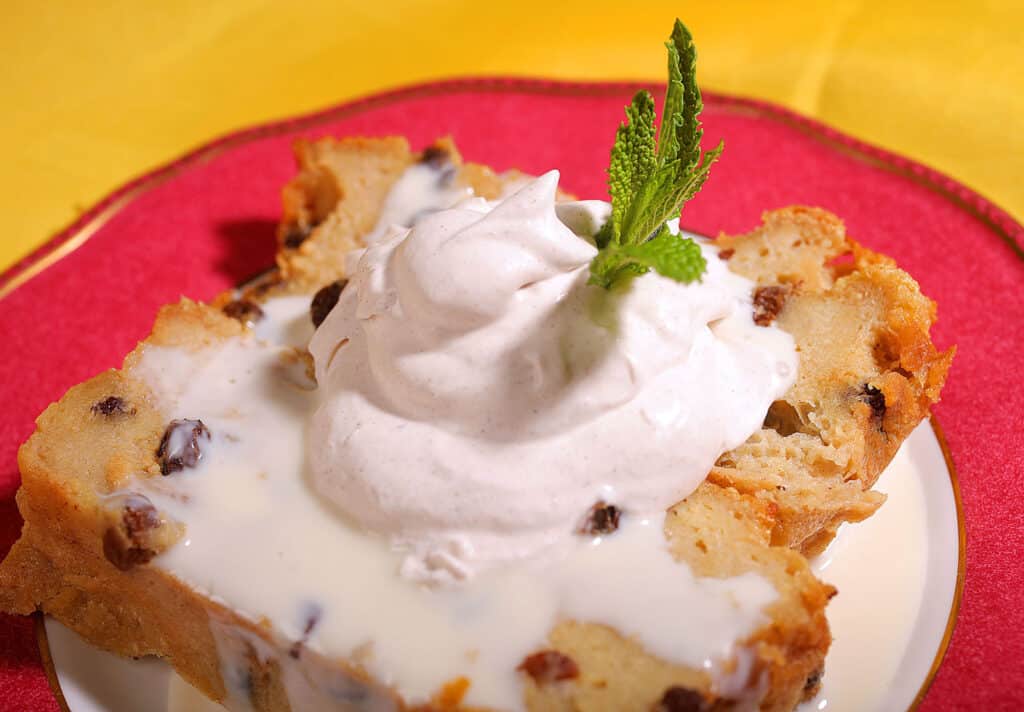
CLASSIC NEW ORLEANS BREAD PUDDING WITH A BOURBON SAUCE
Yield: 9 servings
For bread pudding
1 teaspoon unsalted butter
4 large eggs
1 cup firmly packed light brown sugar
1/2 teaspoon ground cinnamon
1/8 teaspoon freshly grated nutmeg
1 teaspoon pure vanilla extract
1/4 cup bourbon
2 cups half-and-half
8 slices day-old French bread, cut into 1/2-inch cubes (about 4 cups)
1/2 cup raisins, or more if desired
Sprigs fresh mint, for garnish (optional)
Powdered sugar, for serving
For the spiced cream
1/4 cups heavy cream
1/4 cup granulated sugar
1/2 teaspoon ground cinnamon
1/8 teaspoon freshly grated nutmeg
For the bourbon sauce
1 cup heavy cream
1 cup half-and-half
2 teaspoons pure vanilla extract
6 tablespoons granulated sugar
1 tablespoon cornstarch
3 tablespoons bourbon
1. For the bread pudding: Preheat the oven to 350 degrees and grease a 6-cup (9-inch-by-5-inch) loaf pan with the butter.
2. Whisk the eggs, sugar, cinnamon, nutmeg, vanilla and bourbon together in a large mixing bowl until very smooth. Add the half-and-half and mix well. Add the bread and raisins and let the mixture sit for 2 hours, stirring occasionally. Pour mixture into the prepared pan. Bake until the pudding is set in the center, about 55 minutes. Let cool for at least 5 minutes before serving.
3. For the spiced cream: Beat the cream with an electric mixer on high speed in a large mixing bowl for about 2 minutes. Add the sugar, cinnamon and nutmeg and beat again until the mixture thickens and forms stiff peaks, another 1 to 2 minutes.
4. For the bourbon sauce: Heat the cream, half-and-half, vanilla and sugar in a saucepan over high heat, whisking, for 3 minutes. Dissolve the cornstarch in the bourbon. When bubbles form around the edges of the cream, whisk in the bourbon mixture. As the cream boils up, remove the pot from the heat and continue whisking vigorously until thoroughly blended and slightly thickened. Place over low heat and simmer for 1 minute. (This is not a thick cream sauce; it’s meant to be fairly thin.)
5. To serve, cut the pudding into 1-inch thick slices. Lay each slice in the center of a serving plate. Spoon some of the bourbon sauce over the pudding and top with the spiced cream. Garnish with a sprig of fresh mint and powdered sugar.
Per serving: 480 calories; 10 g fat; 6 g saturated fat; 105 mg cholesterol; 9 g protein; 83 g carbohydrate; 62 g sugar; 1 g fiber; 307 mg sodium; 138 mg calcium
Recipe by Emeril Lagasse

